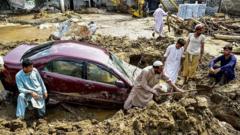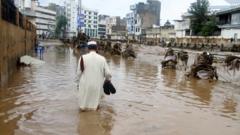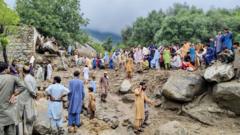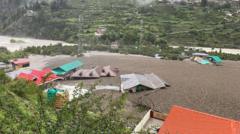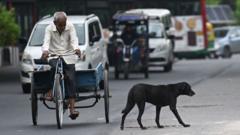As temperatures soar to near-record highs in Northern India, residents of Sri Ganganagar adapt their daily routines amid increasing heat challenges.**
Struggling Against the Heat: Life in India's Hottest City**

Struggling Against the Heat: Life in India's Hottest City**
The escalating temperatures in India pose a severe threat to the lives of millions, impacting communities and livelihoods.**
In the heart of India, the city of Sri Ganganagar has become a focal point of extreme heat, with temperatures climbing to alarming levels. Reports indicate that daytime highs have reached upwards of 49 degrees Celsius (121 degrees Fahrenheit), pushing the limits of human endurance. With about 75% of the nation's 1.4 billion population at risk, the impact of scorching heat is felt far and wide.
For many, the burden of extreme temperatures invalidates the notion of 'escaping the heat.' The residents of Sri Ganganagar embody resilience as they face the dual threats of elevated temperatures and the apparent lack of access to air conditioning. Economic activities predominantly take place outdoors, under the unrelenting sun, where missing work translates to tangible repercussions such as loss of income.
During our recent visit, we witnessed this grueling lifestyle first-hand. Daily rhythms in the region have drastically altered, as individuals adjust to cope with the merciless heat. Many farmers work either at the break of dawn or late at night to avoid the scorching afternoons. Meanwhile, essential services have become overwhelmed, struggle to address the health hazards posed by heat stress and dehydration.
This year, humidity levels have risen considerably, intensifying the discomfort and challenges that already confront the local population. As climate change continues to exacerbate weather patterns in India, the situation becomes more critical, with communities like Sri Ganganagar showcasing how adaptation becomes not merely a choice, but a necessity.
As we continue to explore the implications of living in one of India’s hottest locales, we reflect on the urgent need for action to help lift these communities from the oppressive impacts of extreme climate events, while highlighting the strength and spirit of its residents.
For many, the burden of extreme temperatures invalidates the notion of 'escaping the heat.' The residents of Sri Ganganagar embody resilience as they face the dual threats of elevated temperatures and the apparent lack of access to air conditioning. Economic activities predominantly take place outdoors, under the unrelenting sun, where missing work translates to tangible repercussions such as loss of income.
During our recent visit, we witnessed this grueling lifestyle first-hand. Daily rhythms in the region have drastically altered, as individuals adjust to cope with the merciless heat. Many farmers work either at the break of dawn or late at night to avoid the scorching afternoons. Meanwhile, essential services have become overwhelmed, struggle to address the health hazards posed by heat stress and dehydration.
This year, humidity levels have risen considerably, intensifying the discomfort and challenges that already confront the local population. As climate change continues to exacerbate weather patterns in India, the situation becomes more critical, with communities like Sri Ganganagar showcasing how adaptation becomes not merely a choice, but a necessity.
As we continue to explore the implications of living in one of India’s hottest locales, we reflect on the urgent need for action to help lift these communities from the oppressive impacts of extreme climate events, while highlighting the strength and spirit of its residents.


